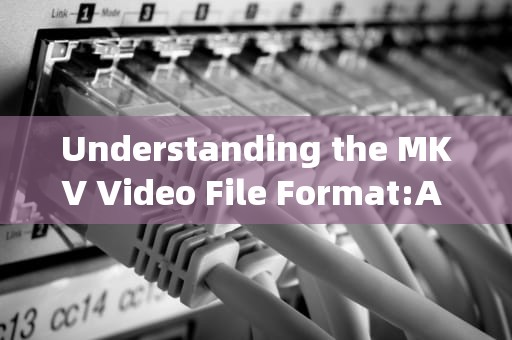本文目录导读:

In the ever-evolving world of digital media, video formats play a crucial role in how we consume, store, and share content. Among the various video formats available, MKV stands out as a versatile and widely used format. This guide will delve into what MKV is, its characteristics, advantages, and use cases, providing a comprehensive understanding of this format.
MKV, short for MPEG-4 Visual, is an open-source video compression format developed by MPEG (Moving Picture Experts Group). It is part of the MPEG-4 family, which also includes formats like H.264 (AVCHD), HEVC (H.265), and VP9. MKV is designed to efficiently compress video content while maintaining high quality and compatibility across different devices and platforms.
The MKV format is primarily used for storing and transmitting video files, and it supports a wide range of resolutions, aspect ratios, and frame rates, making it suitable for various applications, including streaming, video conferencing, and multimedia players.
Before diving deeper into MKV, it's important to understand its place within the MPEG-4 family:
H.264 (AVCHD): This is a widely used video compression standard that offers good compression efficiency and is supported by most modern devices. MKV is compatible with H.264, allowing for cross-format compatibility.
HEVC (H.265): Also known as High Efficiency Video Coding, HEVC provides higher compression efficiency than H.264 and is supported by newer devices and streaming services. MKV can also be converted to HEVC for even better compression.
VP9: Another open-source video compression format, VP9 is known for its high compression efficiency but is less widely supported compared to H.264 and HEVC.
MKV serves as a common container format that can encapsulate video data compressed using any of these standards. This flexibility makes it a popular choice for developers and content creators.
Support for High-Resolution Videos: MKV is well-suited for storing high-resolution (4K/8K) videos, making it a favorite among content creators and streaming platforms.
Multilingual Support: Many MKV files include text or subtitles in multiple languages, enhancing accessibility for a global audience.
Compatibility: MKV files are widely compatible with various devices and software applications, ensuring that videos can be viewed or played back seamlessly across different platforms.
Customization: MKV files can be customized with metadata, such as timestamps, descriptions, and tags, providing flexibility for content management and distribution.
Open-Source Nature: As an open-source format, MKV has a strong community support base, which has led to the development of numerous tools and libraries for encoding, decoding, and manipulating MKV files.
High Quality: MKV files are known for maintaining high video quality even at lower bitrates, making them ideal for streaming over limited bandwidth connections.
Efficient Storage: Due to its compression efficiency, MKV files are smaller in size compared to uncompressed formats, reducing storage costs and bandwidth usage.
Cross-Platform Compatibility: MKV files can be played on a wide range of devices, from smartphones to high-end media servers, ensuring broad accessibility.
Versatility: MKV files can be used for various purposes, including live streaming, video conferencing, and personal entertainment, making them a versatile choice for content creators.
Customizable Metadata: The ability to add metadata to MKV files allows for better organization and retrieval of content, which is particularly useful for large-scale media management systems.
While MKV offers numerous advantages, it also has some limitations:
Limited Hardware Support: Not all devices and software applications support MKV natively, which can lead to compatibility issues.
Encoding Complexity: Encoding MKV files with high quality or specific metadata requirements can be technically challenging, requiring expertise in video encoding.
Licensing Considerations: Although MKV is an open-source format, the use of certain features or metadata may require licensing agreements with the respective developers.
Streaming Services: Platforms like Netflix, Hulu, and Disney+ often use MKV as their video container format to ensure compatibility across a wide range of devices.
Live Streaming: Event organizers and broadcasters use MKV to stream live content to millions of viewers, ensuring high-quality playback across different platforms.
Video Editing: Professionals use MKV files for video editing and post-production, as the format supports easy manipulation and integration with various tools.
Multimedia Players: Devices like Apple TV, Chromecast, and Fire TV support MKV files, making them a popular choice for home entertainment systems.
Cloud Storage: Platforms like Amazon Prime Video and Google Drive use MKV as their default video container format, ensuring seamless playback across cloud-based services.
As video consumption continues to grow, the importance of MKV and other MPEG-4 formats will likely increase. With advancements in hardware and software, MKV is expected to remain a dominant format for years to come. Additionally, the open-source nature of MKV will continue to foster innovation, with more tools and libraries being developed to support this format.
In summary, MKV is a versatile, high-quality, and widely compatible video format that has become an essential part of modern digital media. Its ability to support high resolutions, multilingual subtitles, and customizable metadata makes it a popular choice for content creators, streaming platforms, and consumers alike. While there are some limitations, the advantages of MKV far outweigh its drawbacks, making it a future-proof choice for video content.
随着互联网的普及和信息技术的飞速发展台湾vps云服务器邮件,电子邮件已经成为企业和个人日常沟通的重要工具。然而,传统的邮件服务在安全性、稳定性和可扩展性方面存在一定的局限性。为台湾vps云服务器邮件了满足用户对高效、安全、稳定的邮件服务的需求,台湾VPS云服务器邮件服务应运而生。本文将对台湾VPS云服务器邮件服务进行详细介绍,分析其优势和应用案例,并为用户提供如何选择合适的台湾VPS云服务器邮件服务的参考建议。

工作时间:8:00-18:00
电子邮件
1968656499@qq.com
扫码二维码
获取最新动态
